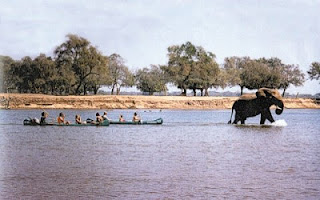The Kafue River, winding across the plains below,
flows into the Zambezi and is typical of the whole riverine system; shallow,
sluggish meandering that runs for ever past reed and the sand island, forested riverbank,
lurking crocodiles, snorting hippo, wading birds, and cobwebs of dew at dawn.
The “big river” or Zambezi rises in Zambia and runs along the border which
divides that country form Zimbabwe. It is 2,740 kilometers long and produces as
much water as all the rivers of South Africa combined.
Vasco da Gama, the great Portuguese explorer, was
the first European to see the mouth of the river In the Indian ocean coast, on
22nd January 1498. He named it the “river of good omens” (Rio dos
Bons Signaes) yet history has never reflected his sentiment, neither for
Portuguese entrepreneurs trying to muscle in on the Swahili gold ivory and the
slave trade of the interior, nor for missionary David Livingstone who 400 hundred
years later walked the whole length of the river. His wife Mary born in faraway
Kuruman on the edge of the Kalahari, lies buried in an all but forgotten grave
not far from the delta where the wind and the salt and the inexorable march of
the jungle shore hide her last resting place.
The Zambezi valley, 50kms wide between the smoky
blue massif of pyramids-shaped mountains besides the river on the Zambian side
and the baobab and mopane tree covered escarpment in Zimbabwe, is hot and
rugged wilderness. On the alluvial flood plains Mana Pools the river can be five
kilometers wide, and in the dry season attracts vast quantities of impala,
buffalo lion nearly 400 species of birds, and elephants that amble
across the river between the two countries.




























